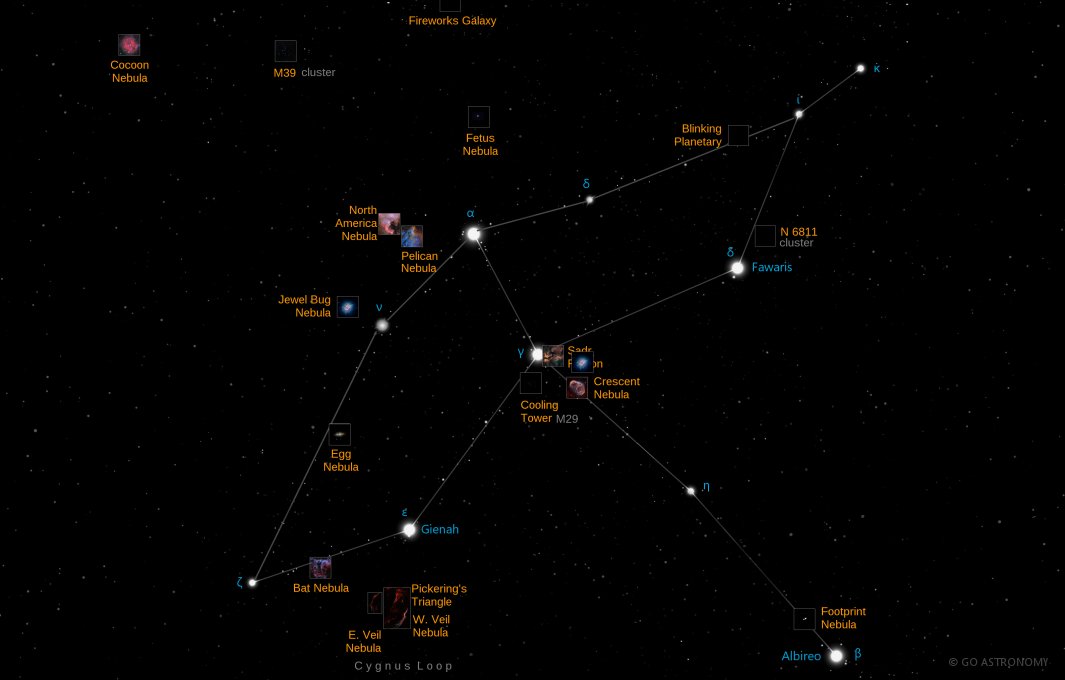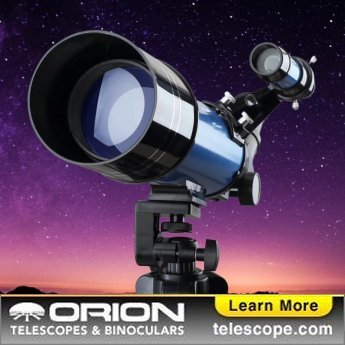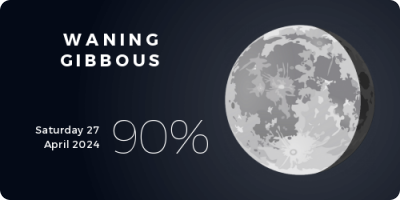Cygnus, the Swan (Cyg)
(SIG-nus)
The Northern constellation of Cygnus, the Swan, is best viewed in Fall during the month of September.
Cygnus is the 16th largest constellation. It's brightest star is Deneb at magnitude 1.25. The boundary of the Cygnus constellation contains 85 stars that host known exoplanets.
Red supergiant KY Cygni is the 6th largest known star in the universe at 1,400 times the size of the Sun.
- Pronunciation:
- SIG-nus
- Meaning:
- Swan
- Genitive:
- Cygni
- Abbreviation:
- Cyg
- Asterism:
- Northern Cross
- Constellation Family:
- Hercules
- Hemisphere:
- Northern
- Quadrant:
- NQ4
- Visibility:
- 90° N - 40° S
- Best viewing month*:
- September
- Area:
- 804 sq. degrees
- Size:
- 16th largest
- Right Ascension (avg):
- 20h 36m
- Declination (avg):
- 43°
- Brightest star:
- Deneb (1.25)
- Stars with planets:
- 85
- X-ray stars:
- 2 (binary) stars
Brightest Stars in Cygnus
The 10 brightest stars in the constellation Cygnus by magnitude.
- Star
- Magnitude
- Spectral class
- Alpha Cygni (α Cyg)
- 1.25
- A2Ia
- Gamma Cygni (γ Cyg)
- 2.23
- F8Ib
- Epsilon Cygni (ε Cyg)
- 2.48
- K0III
- Delta Cygni (δ Cyg)
- 2.86
- B9.5III
- Beta Cygni (β1 Cyg)
- 3.05
- K3II+
- Zeta Cygni (ζ Cyg)
- 3.21
- G8II SB
- Xi Cygni (ξ Cyg)
- 3.72
- K5Ibv SB
- Tau Cygni (τ Cyg)
- 3.74
- F1IV
- Iota Cygni (ι Cyg)
- 3.76
- A5Vn
- Kappa Cygni (κ Cyg)
- 3.8
- K0III
Double Stars in Cygnus
These are the brightest and easiest-to-find double, triple, and quadruple star systems in the constellation Cygnus. Also see all star clusters.
- Star system
- Magnitudes
- Type
- Beta Cygni
- 3.2, 4.7
- double
- 31 Cygni
- 3.9, 7.0, 4.8
- triple
- 61 Cygni
- 5.2, 6.1
- double
Star Clusters in Cygnus
The most notable and easy-to-find star clusters in the constellation Cygnus . Also see all star clusters.
- Star cluster
- Catalog #
- Cluster type
- Cooling Tower
- M29
- open
- IC 5146
- open
- Messier 39
- M39
- open
- NGC 6834
- open
Nebulae in Cygnus
Notable and easy-to-find nebulae in the constellation Cygnus . Also see all nebulae.
- Nebula name
- Catalog #
- Nebula type
- Bat Nebula
- supernova remnant
- Blinking Planetary Nebula
- C15
- planetary
- Cocoon Nebula
- C19
- reflection
- Crescent Nebula
- C27
- emission
- Cygnus Loop
- supernova remnant
- Eastern Veil Nebula
- C33
- supernova remnant
- Egg Nebula
- protoplanetary
- Fetus Nebula
- planetary
- Footprint Nebula
- protoplanetary
- North America Nebula
- C20
- H II region
- Pelican Nebula
- H II region
- Sadr Region
- emission
- Soap Bubble Nebula
- planetary
- Soccer Ball Nebula
- planetary
- Veil Nebula
- C33/C34
- supernova remnant
- Western Veil Nebula
- C34
- supernova remnant
- Northern Coalsack
- dark
- Forsaken Nebula
- emission
Galaxies in Cygnus
The most notable galaxies in the constellation Cygnus. Also see all galaxies.
Neutron Stars in Cygnus
These are the most well-known neutron stars in the constellation Cygnus. Although neutron stars cannot be seen in any amateur telescope, they are at the center of many supernova remnant nebulae, which can be seen. Also see all neutron stars.
Black Holes in Cygnus
These are the most well-known smaller (non-supermassive) black holes in the constellation Cygnus. Although black holes cannot be seen directly, the smaller ones are at the center of some star clusters and supernova remnant nebulae, which can be seen. Supermassive black holes are at the center of most galaxies, such as Sagittarius A* at the center of our Milky Way galaxy. Also see all black holes.
- Black hole
- Type
- Cygnus X-1
- stellar
- Cygnus X-3
- stellar
- V404 Cyg
- stellar
The Swan Constellation
Located in the northern sky, Cygnus, the Swan, is one of the most recognizable constellations due to its prominent cross shape. As a rich constellation in a densely star-packed region of the Milky Way, Cygnus has been a cornerstone of mythologies, a guiding post for navigators, and a treasure trove for astronomers.
Historical Background
Cygnus is among the 48 constellations listed by the 2nd-century Greek astronomer Ptolemy and remains one of the 88 modern constellations recognized by the International Astronomical Union today. The constellation's name, Cygnus, is Latin for "swan" and is associated with various myths in different cultures. Most notably, it's often associated with the Greek myth of Zeus disguising himself as a swan to seduce Leda, the queen of Sparta.
Main Features and Location
Cygnus is positioned in the fourth quadrant of the Northern Hemisphere (NQ4) and can be seen at latitudes between +90? and -40?. Its location in the plane of the Milky Way means it is rich in deep sky objects and is home to a variety of interesting features.
The constellation is made up of several bright stars forming a pattern that has been commonly referred to as the Northern Cross. The body of the swan is depicted by the line of stars that form the beam of the cross, with Deneb, a bright supergiant star, marking the tail of the swan.
Significant Stars
Deneb, the alpha star of Cygnus, is one of the vertices of the Summer Triangle, along with Vega in Lyra and Altair in Aquila. Deneb, meaning "tail" in Arabic, is a white supergiant and is one of the most luminous stars known. It's positioned about 2,600 light-years away from the Sun.
Other significant stars include Sadr or Gamma Cygni, lying at the intersection of the Northern Cross; Albireo (Beta Cygni), a beautiful double star renowned among amateur astronomers for its striking color contrast; and Cygnus X-1, a notable X-ray source believed to be a black hole.
Deep Sky Objects
Beyond the prominent stars, Cygnus also boasts an array of fascinating deep sky objects, thanks to its position along the Milky Way. Among them is the North America Nebula (NGC 7000), an emission nebula named after its resemblance to the North American continent. There's also the Veil Nebula (NGC 6960/NGC 6992), which is the visible remnant of a supernova explosion that occurred between 10,000 and 20,000 years ago.
Observation
For observers in the Northern Hemisphere, Cygnus is easy to find during the summer months when it reaches high overhead in the night sky. The main asterism, the Northern Cross, is particularly visible in the December evening sky, lying in an almost horizontal position.
In the Southern Hemisphere, Cygnus appears low in the northern sky during winter months. Its main stars can be observed, but they don't climb high in the sky, and viewing conditions are heavily dependent on the observer's latitude and the surrounding light pollution.
* Constellation shown for northen hemisphere skies. For the southern hemisphere, constellations appear rotated 180 degrees (upside-down and left-right reversed) from what is shown. Remember that seasons are reversed too - summer in northern latitudes is winter in southern latitudes.
** Circumpolar constellations are visible year-round in the hemisphere listed (and not at all in the opposite hemisphere).





